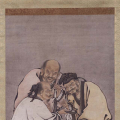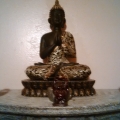Welcome home! Please contact lincoln@icrontic.com if you have any difficulty logging in or using the site. New registrations must be manually approved which may take several days. Can't log in? Try clearing your browser's cookies.
The lion's gaze
 Carameltail
UK Veteran
Carameltail
UK Veteran
'Padmasambhava said that when a stick is thrown to a dog, the dog will chase the stick. When you throw a stick to a lion, the lion will chase you. The lion gazes steadily at the source, the thrower. A dog’s gaze follows the object, the stick. Similarly, our source of experience is our own mind. … An emotion, like anger, represents the stick.
The source hurling that emotion is our mind. It is the mind that projects. … a mind functioning beyond the jumbling of discursive emotions develops a steady and awake inner gaze, piercing the welter of thoughts.'
Sherab, P. & Dogyal, T. (1998). The Lion’s Gaze.
I think, it's a nice way to think about the importance of having awareness, of the source of feelings we experience within ourselves.
6





Comments
Not my experience. My emotions come from the body. They tend to unfold before the mind gets a chance to process them and are therefore more instantaneous and instinctual ... and that quite frankly is what emotional reactions are for ... speed, survival ...
Indeed. That is the aware mind controlling, overseeing, disciplining, being mindful etc. of emotional arisings ...
Where do your emotional hurls come from?
I feel it is that when we allow our emotions to dictate out thoughts and actions, we allow ourselves as to be controlled by outward or external forces. However, while acknowledging our emotions, we srtive to use our awareness and our mind, (which can be one and the same), to direct or rein in or alter our emotion to facilitate a positive interaction within ourselves (internal environment) and with our external environment. This is the action of the "aware mind" as mentioned by @lobster.
@lobster.
I agree it's not always the mind that produces these things. So healthy emotions can arise in body for example when you are in a dangerous situation aren't so dictated by the mind and constructs. Well unless you want to view reality as a construct ofc. But yes this is a healthier way to experience.
I suppose in the case of emotional reactions that trigger responses for example what people say, involves the processes of the mind or holding of fear or other emotions. Much of these sorts of responses I suppose are mind constructed. Or perhaps exaggerations of an emotion so a combination of both
To answer question for me I get emotional feelings both directly from body, and those relating to mind and I still have much problems atm. (In fact I haven't really been feeling too well )
)
I also experience the fact that peoples emotional problems can be shared to some extent. Especially if you have any existing vulnerabilities.
I suppose one thing though is unhealthy emotional states can be held in the physical body and It can become a holding point for unresolved feelings.
Yes indeed. Welcome to nude Newbuddhist incidentally.

You are quite right in your analysis and I feel a healthy emotional positivity, a balance of body energy and a healthy mind are all our first steps towards the 'hood. Buddhahood.
Sorry to hear you are unwell.
I think yoga or Qi-Ong is best if possible. My unhealthy emotional states were locked into an unhealthy breath. Daily meditation has been of great value ...
https://awakened.ca/medicine-buddha-meaning/
Look after yourself
@lobster said:
I’ve heard this is true of fear. It unfolds at a subconscious level. Unlike when, say, conversing, the brain processes the interaction at a level where conscious volition is present, making right speech possible, the brain conversely would process a sudden, threatening sound on another level where conscious volition isn’t present, making us freeze. This forces us, against our will, to stop whatever we’re doing to assess the threat. After that initial lock down, though, there comes a first moment of conscious volition that enables us both to choose how we interpret the threat and how we accordingly respond.
To me this is where we find the line between what the Buddha called in the Kamma Sutta old and new kamma. The process of hearing a sound, fearfully recognizing a possible threat and freezing, along with the ears and brain through which the process unfolds, is old kamma running its course, the result of a past mind conditioned by ignorance. Like a dog chasing a stick, the kammic results follow the nature of that deluded mind, polluted with effluents.
New kamma, on the other hand, begins with that first moment of conscious volition. While old kamma may feel fear and freeze the body, new kamma allows us to recolor our assessment of the threat. As the movements led by Gandhi and MLK demonstrated, this can even circumvent the fight or flight response. Likewise, in another sutta I can’t recall, the Buddha gave a seemingly impossible instruction to cultivate metta while being beaten.
That makes a little more sense in the Ariyamagga Sutta, where the Buddha outlines three types of kamma: dark kamma with dark result; bright kamma with bright result; and dark and bright kamma with dark and bright result. Human experience falls into that very last category of dark and bright result, while the inclinations of our deluded minds lean toward dark and bright kamma but can go any way. Whatever emotional state arises is old kamma coming to fruition, but there is a first moment of volition enabling us to choose how we view and consequently react to it. Like a dog, a deluded mind will once again chase the stick. But, a mind inclining toward wisdom will, like a lion, not fall for it. That comes under a fourth type of kamma that is “neither dark nor bright with neither dark nor bright result, leading to the ending of kamma.”
@Carameltail, to me old kamma throws sticks and, like a deluded dog, inclines to chase them, resulting in another thrower. But new kamma, like a lion, need not be fooled, seeing instead with right view, not chasing the stick, not resulting in another thrower.
Once again, the problem of language rears its dog and lion head. The term feelings may simply mean too many things to too many people. But from the Buddhist perspective, there are only three feelings to be considered:
And as we know from the Gotama Sutta,
So, to read this sutta is to know that the start of this causal sequence is ignorance and the end is aging and death (suffering). Apparently, the Buddha just wasn't that concerned about a more specific source of feelings.
@jwredel, that perspective goes straight for the jugular. From another the Satipatthana Sutta defines 6 classes:
From another the Satipatthana Sutta defines 6 classes:
Those may be organized into two categories, worldly and spiritual, each with the three affective qualities of liking, disliking and shrug. Discerning the source of a sensation as worldly or spiritual is, from one perspective, important for experientially synthesizing those two bullet lists. From this perspective some sticks should be chased, examined and dropped for more useful sticks.
The jhanas are a good example. The first jhana drops worldly sticks to chase spiritual ones, e.g., rapture and happiness born of … not-worldly sticks. Next, the second jhana retrieves rapture and happiness. Then, the third jhana drops rapture. Finally, the fourth jhana drops happiness to retrieve a more refined, spiritual stick that’s neither liking nor disliking.
As my teacher would say ... Wonderful! I would quibble a bit with the word finally, as the Anupada Sutta does go on to discuss 5 more 'sticks' that Sariputta chases. But the metaphor is a great one, especially the notion of grabbing the stick in our teeth and shaking it and thinking that this stick is the best thing in the world. (Only to be distracted by that stinky dead worm that we proceed to roll around on.)
And when we've chased enough sticks (and rolled on enough worms) ... AHAH!